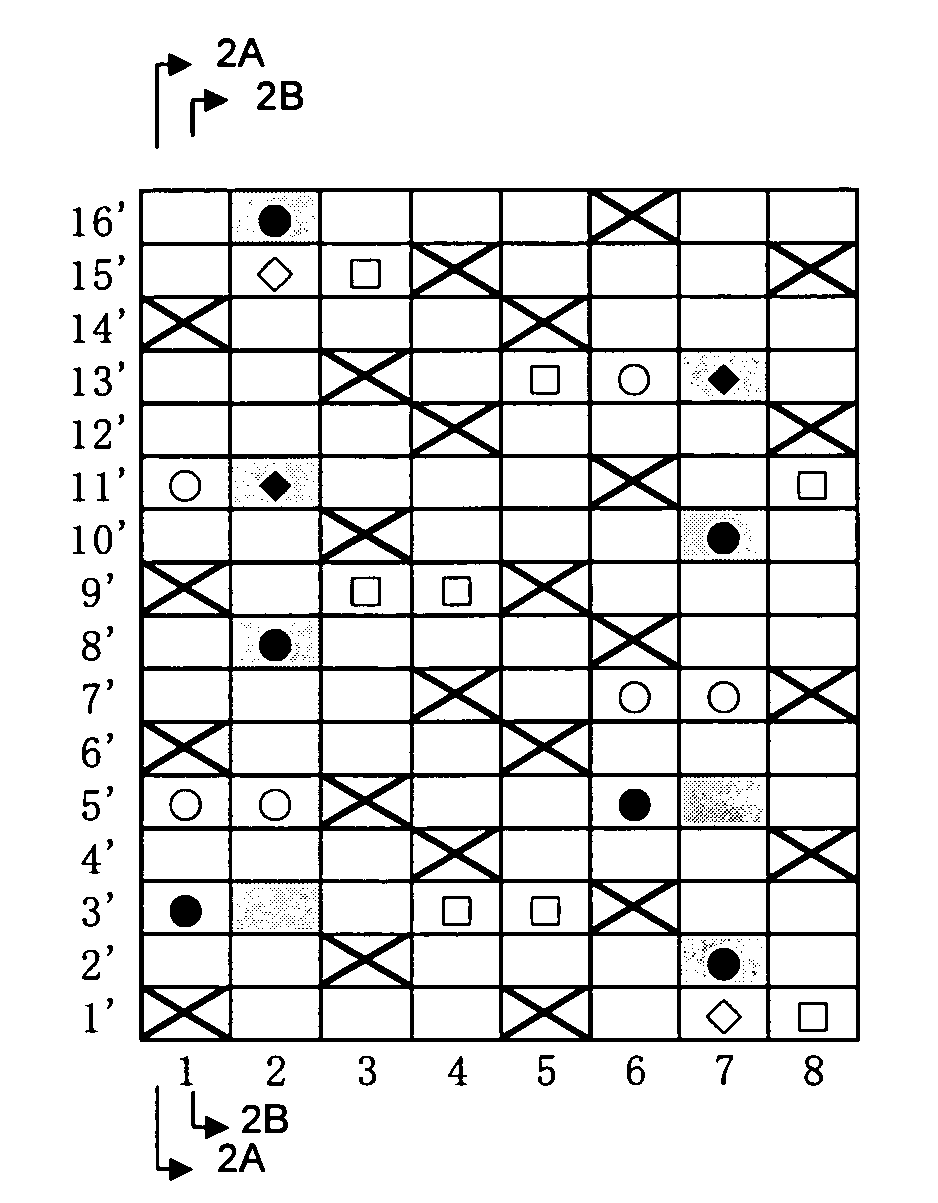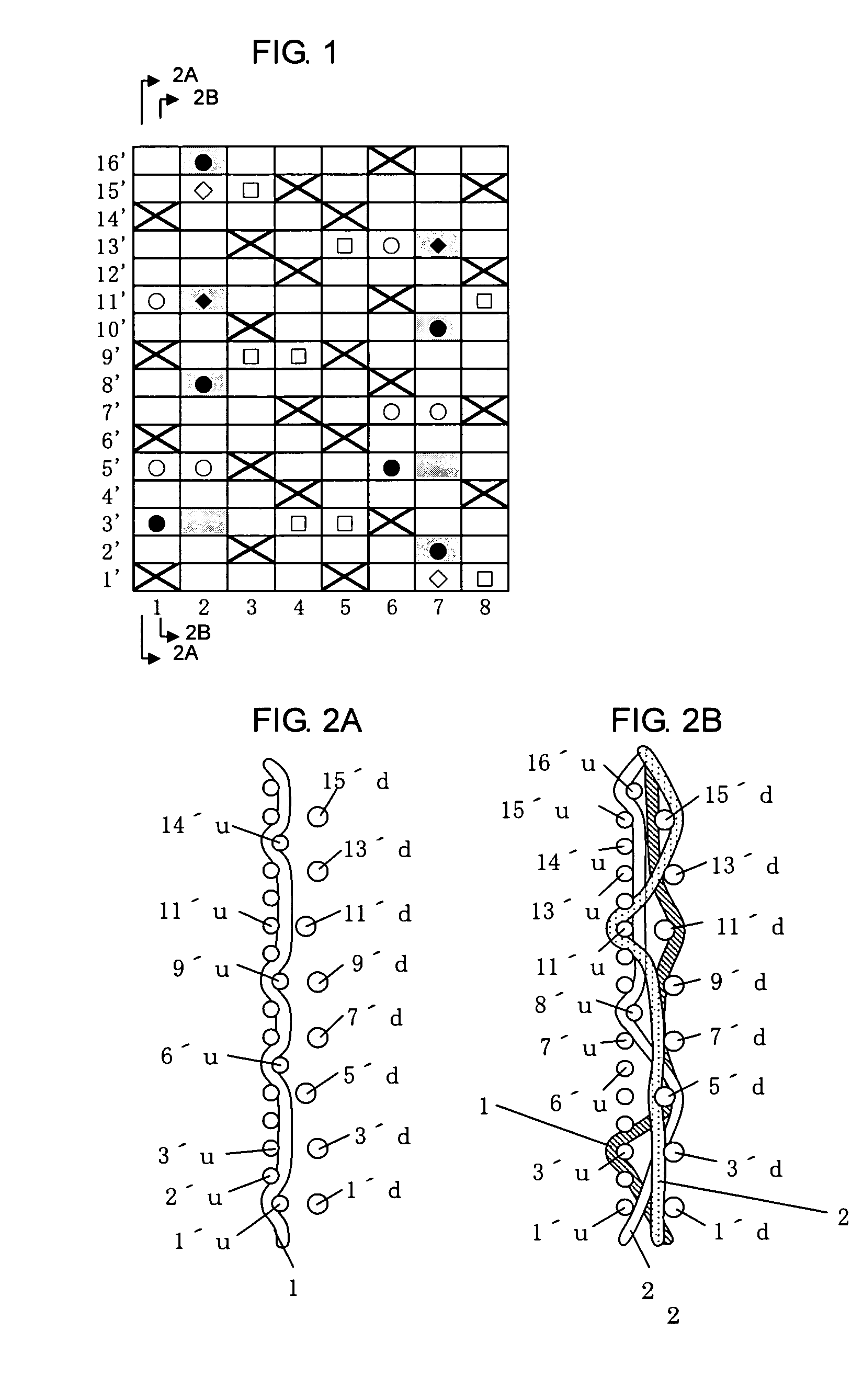Industrial two-layer fabric
- Summary
- Abstract
- Description
- Claims
- Application Information
AI Technical Summary
Benefits of technology
Problems solved by technology
Method used
Image
Examples
example 1
[0073]FIG. 1 is a design diagram of a fabric of Example 1 of the present invention. FIGS. 2A and 2B include cross-sectional views taken along the line 2A-2A of an upper surface side warp 1 and that of a warp binding yarn 1 and a cross sectional view taken along the line 2B-2B of two warp binding yarns 2 respectively, each illustrated in the design diagram of FIG. 1. FIG. 3 is a plan view, viewed from the upper surface side, of a fabric woven based on the design diagram of FIG. 1. For convenience of explanation, indicated at numeral 1 in the design diagram of FIG. 1 are both warp 1 and warp binding yarn 1, which is also applicable to numeral 6. Warp 2 means two warp binding yarns, which is also applicable to warp 7. This fabric is a 16-shaft two-layer fabric having two sets of one upper surface side warp and three warp binding yarns. Warps 1 and 2 constitute one set, while warps 6 and 7 constitute another one set. The other warps 3, 4, 5 and 8 are each a warp set composed of an upper...
example 2
[0086]FIG. 4 is a design diagram of a fabric of Example 2 according to the present invention. FIGS. 5A and 5B include cross-sectional views of an upper surface side warp 1 and that of a warp binding yarn 1 and two warp binding yarns 2, each illustrated in the design diagram of FIG. 4, and these three warp binding yarns get together and form a design corresponding to a warp on the upper side surface. In the design diagram of FIG. 4, indicated at numerals 1 and 5 are pairs of an upper surface side warp and a warp binding yarn, indicated at numerals 2 and 6 are pairs of two warp binding yarns, and indicated at numerals 3, 4, 7 and 8 are pairs of an upper surface side warp and a lower surface side warp.
[0087] The upper side surface is composed of warps having a ¼-½ design and wefts having a ⅓ design, as in Example 1. Each of the warp binding yarn 1 and two warp binding yarns 2 does not constitute a ¼-½ design on the upper side surface, but they get together and cooperatively form a ¼-½...
example 3
[0090]FIG. 6 is a design diagram of a fabric of Example 3 according to the present invention. FIGS. 7A and 7B include cross-sectional views of an upper surface side warp 1 and that of a warp binding yarn 1 and two warp binding yarns 2, each illustrated in the design diagram of FIG. 6. These three warp binding yarns get together and form a design corresponding to a warp on the upper side surface. In the design diagram of FIG. 6, indicated at numerals 1 and 5 are pairs of an upper surface side warp and a warp binding yarn, indicated at numerals 2 and 6 are pairs of two warp binding yarns, and indicated at numerals 3, 4, 7 and 8 are pairs of an upper surface side warp and a lower surface side warp.
[0091] The upper side surface is composed of warps having a ¼-½ design and wefts having a ⅓ design, as in Example 1. Each of the warp binding yarn 1 and two warp binding yarns 2 does not constitute a ¼-½ design on the upper side surface, but they get together and cooperatively form a ¼-½ des...
PUM
 Login to View More
Login to View More Abstract
Description
Claims
Application Information
 Login to View More
Login to View More - R&D
- Intellectual Property
- Life Sciences
- Materials
- Tech Scout
- Unparalleled Data Quality
- Higher Quality Content
- 60% Fewer Hallucinations
Browse by: Latest US Patents, China's latest patents, Technical Efficacy Thesaurus, Application Domain, Technology Topic, Popular Technical Reports.
© 2025 PatSnap. All rights reserved.Legal|Privacy policy|Modern Slavery Act Transparency Statement|Sitemap|About US| Contact US: help@patsnap.com



